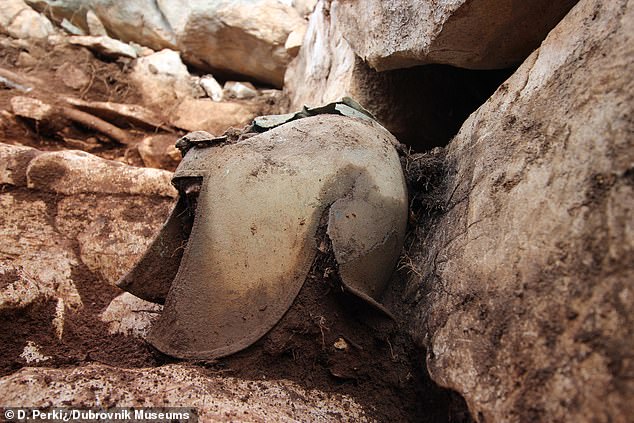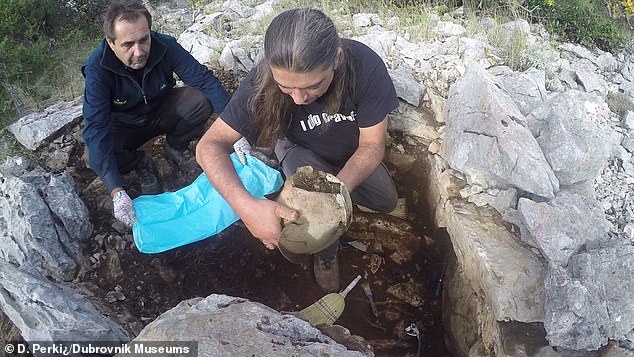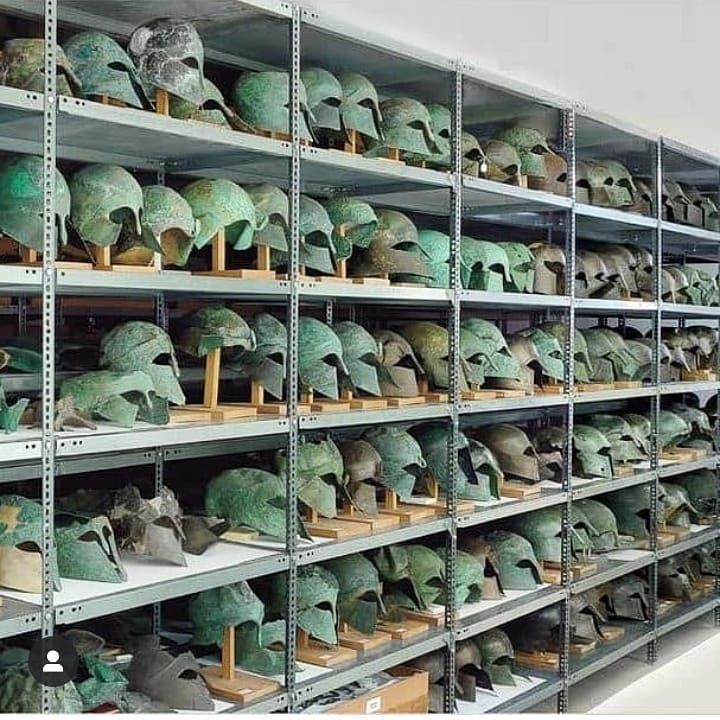An ancient Greek war helmet has been unearthed in a rock-cut tomb where a warrior was laid to rest more than 2,000 years ago.
The Illyrian helmet still boasts its iconic open-faced design, which was first developed in the Peloponnese region of Greece during the 8th and 7th centuries BC.
The tomb was built on the side of a mountain in Zakotarac, on the Pelješac peninsula, in southern Dalmatia, Croatia.
Archaeologists have also uncovered a trove of ancient weapons and unearthed another set of remains of a woman buried with a bronze bracelet around her wrist.

An ancient Greek war helmet has been unearthed in a rock-cut tomb where a warrior was laid to rest more than 2,000 year ago
The discovery was made by archaeologists at Zagreb University, in collaboration with Dubrovnik Museums, which believes the grave was used for an elite member of the Greek military.

The Illyrian helmet was first used by ancient Greek Etruscans and Scythians and was later adopted by Illyrians – earning its well-known name.
The type of helmet also became popular in Italy, where it was constructed from ivory.
The helmet became obsolete in most parts of Greece in the early 5th century BC – and its use in Illyria ended by the 4th century BC.

The Illyrian helmet still boasts its iconic open-faced design that was developed in the Peloponnese during the 8th and 7th centuries BC

The tomb was built on the side of a mountain residing in Zakotarac, located on the Pelješac peninsula, in southern Dalmatia, Croatia
Along with finding the helmet used during the Greco-Persian Wars, the team uncovered a number of ‘grave goods’, which were personal items buried with the dead.

Some fifteen bronze and silver fibulae, ten needles or pins, several spiral bronze ornaments and pincers as well as several hundred glass paste and amber beads, once parts of a necklace were all in the tomb.
Dr Domagoj Perkić, a curator with Dubrovnik Museums, said: ‘To date, more than thirty different vessels have been defined, mainly of Greek provenance, probably from the main Attic and Italic workshops.’

Some fifteen bronze and silver fibulae, ten needles or pins, several spiral bronze ornaments and pincers as well as several hundred glass paste and amber beads, once parts of a necklace , and pots were all in the tomb
‘It has to be emphasized that these were the most expensive kinds of pots of the time, which the local population put alongside the deceased as grave goods for their life beyond the grave.’

‘Whether these vessels were bought or plundered during acts of piracy cannot be known, but those who gave them were very certainly aware of their value.’
The warrior, according to researches, was buried wearing the helmet, as it sits where his skull once was – it has deteriorated over the last thousands of year.
The team found the tomb while restoring damaged burial mounds in the area, which they believe was once seen as a sacred place.
The warriors mound is more than nine feet deep and six feet wide, and his body was laid to rest in the west-east direction.




